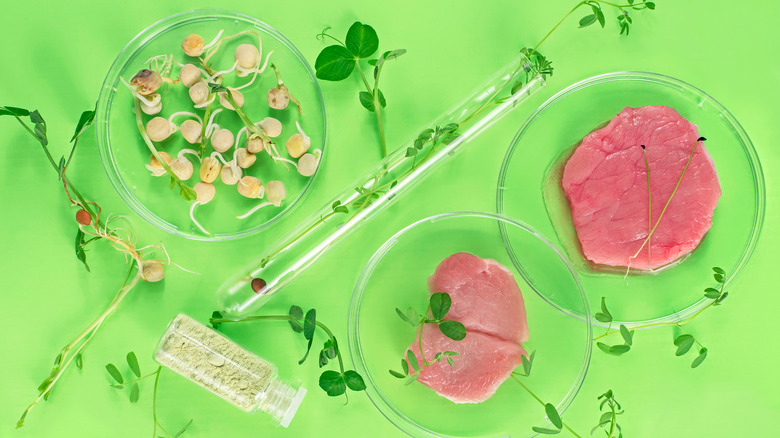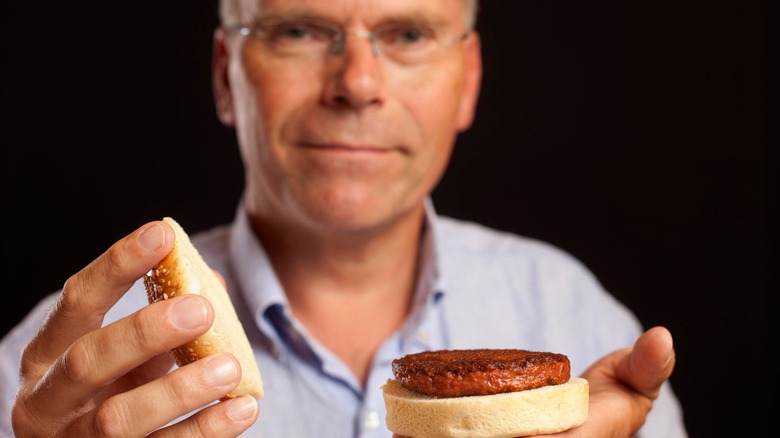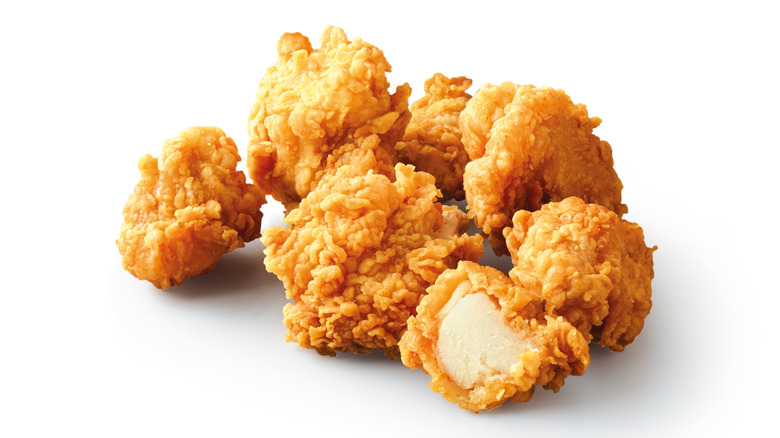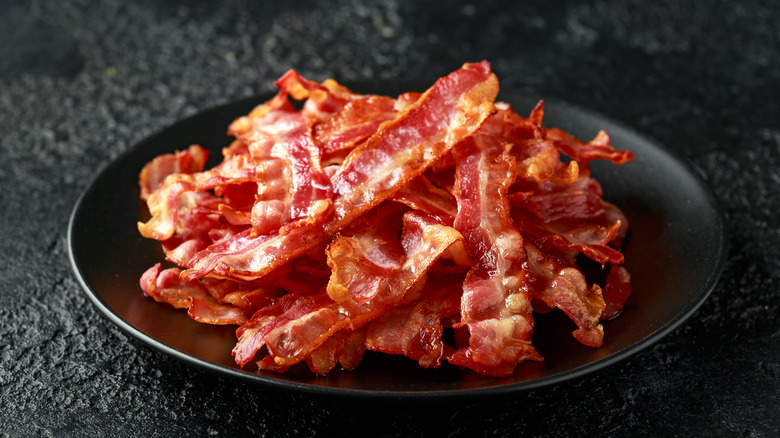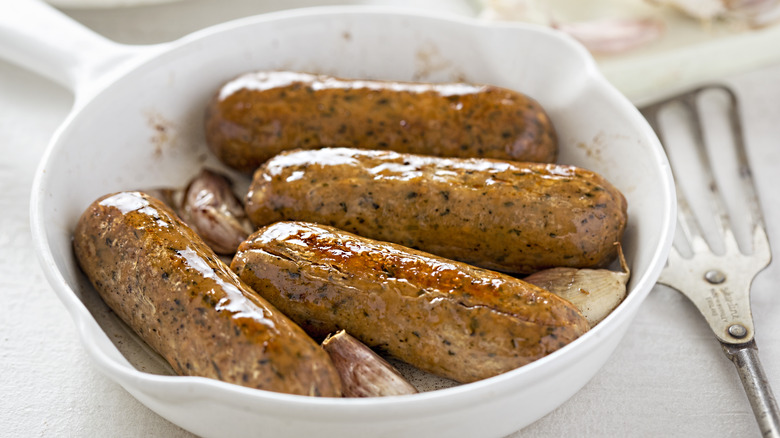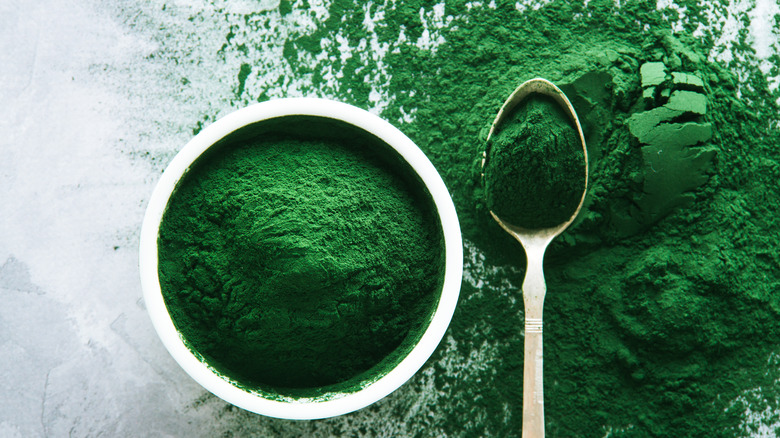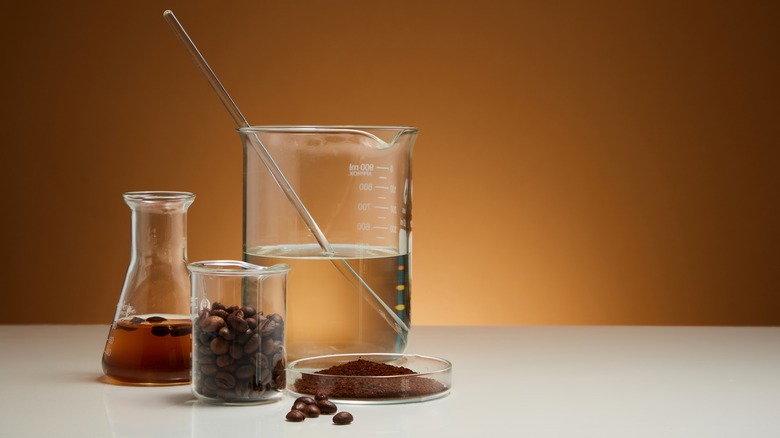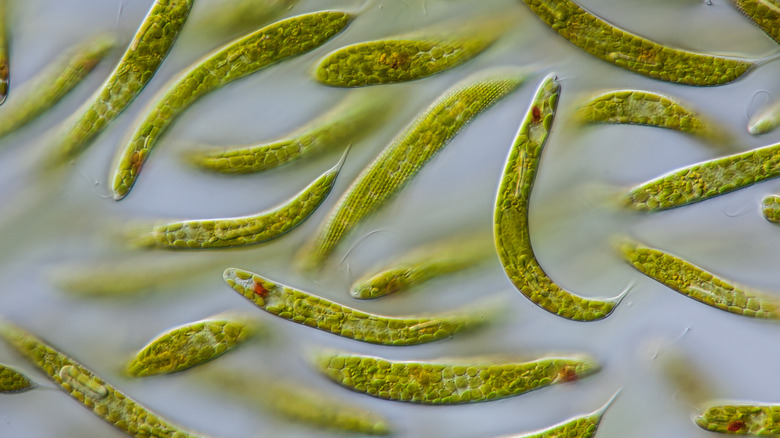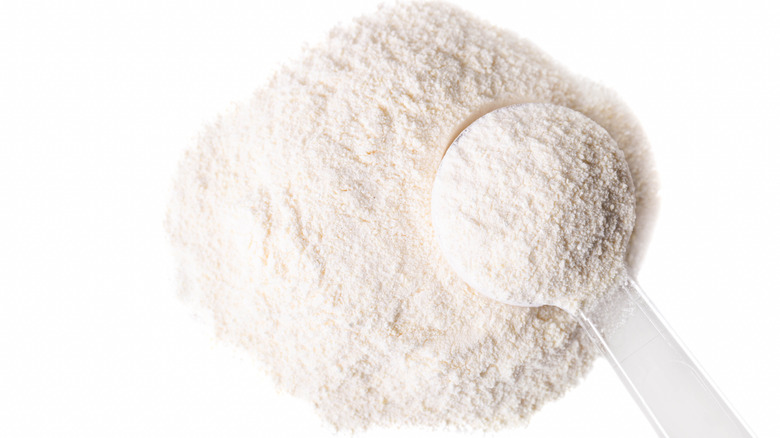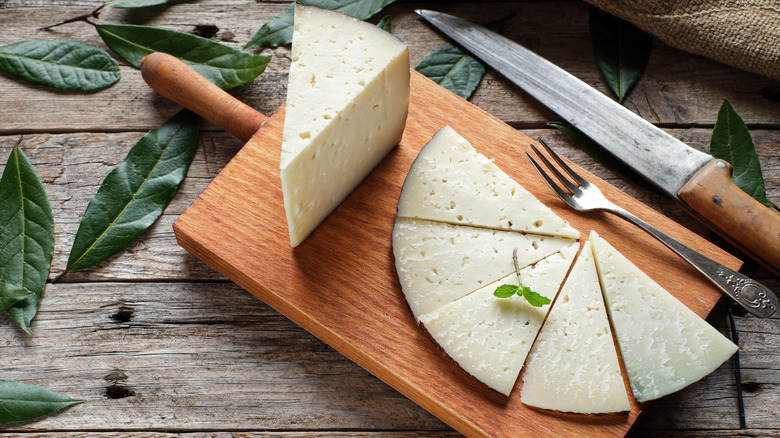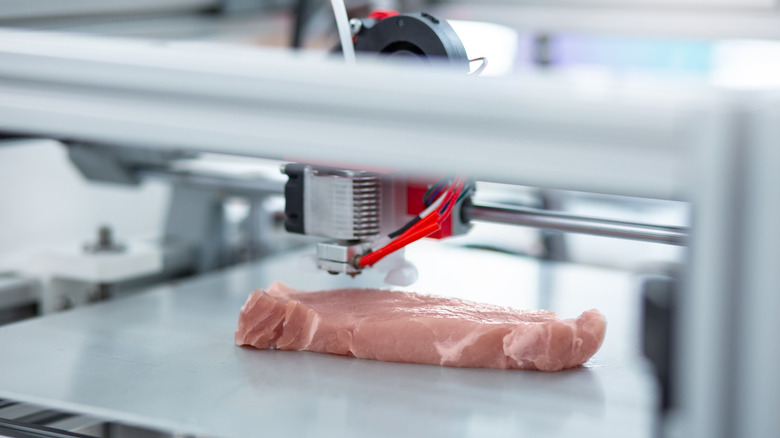Lab-Grown Foods That Could Help Save The Planet
Whether we like it or not, the world is changing, and our societies must change in order to adapt. One of the biggest things that needs to change is our approach to food in terms of both consumption and production. The idea that lab-grown foods could be a game changer for your health and the planet is steadily gaining popularity. The UN estimates that our planet is now home to 8 billion people, and producing food to feed the world is exacting a heavy toll on the environment.
As Bloomberg reported in 2020, the world could easily produce enough food to feed everyone. The problems, therefore, aren't about quantity, but about how food is produced and distributed. Quite simply, the agricultural industry across the planet is in desperate need of an overhaul to fix its many unsustainable and exploitative practices. With the steady march of climate change side effects becoming ever more pressing, improved sustainability is vital. According to the USDA, agriculture contributes over 11% of all greenhouse gas emissions in the U.S. As well as carbon dioxide, this includes gasses that trap even more heat in Earth's atmosphere, like methane and nitrous oxide. Other problems are ethical, like factory farming — which notoriously keeps animals in terrible conditions (via ASPCA) — and the fact that the agricultural industry is rife with exploitation and human rights abuses (via BSR). Alleviating or eliminating problems like these will be a challenge, but many scientists are optimistic that lab-grown foods make for a promising solution.
Beef without cows
Cattle farming takes up more space than any other form of agriculture. According to the UN's Food and Agriculture Organisation, 26% of land that is not covered in ice is used for grazing livestock, and one-third of all croplands are used to produce feed for them. This could be reduced dramatically if beef were produced without needing to rear cattle, and the technology to do this already exists.
Lab-grown meat is commonly known as cultivated or cultured meat, and it's produced using techniques originally developed in medical science. As an article in the journal Frontiers in Nutrition explains, it revolves around stem cells. Medical debates may have given stem cells something of a bad name but, per Scitable, these are really just undifferentiated cells found in all living things. They can be used to grow cells of any kind, like the muscle and fat cells that make up meat. The concept is so promising that it's already spawned an entire field of study known as cellular agriculture, according to Open Access Government.
Per Frontiers in Nutrition, the first burger made from cultivated beef was unveiled in 2013 by a professor from Maastricht University named Mark Post. Labiotech reports that while this first burger cost nearly a quarter of a million dollars to produce, the price has since fallen to around $10 per burger. Cultivated beef is already being sold by several companies, some of which are even run by vegetarians.
Slaughter-free chicken
In 2020, the world's first lab-grown chicken got the green light for sale in Singapore. As the South China Morning Post reports, the meat they were selling was not beef but slaughter-free chicken, produced by Eat Just. So far, the cultivated chicken has proved so successful in Singapore that the country is due to open Asia's largest lab-grown meat facility in 2023.
According to a study published in Appetite, cultivated meat is more accepted in Singapore than in the U.S. There, people are motivated by a cultural trait called kiasuism, which is the desire to uphold a good social image motivated by a "fear of losing out or being left behind" (not entirely dissimilar to FOMO). Acceptance of cultivated meat is a big part of persuading people to eat it and, according to ScienceLine, this varies across populations in different countries, with many people still having knee-jerk reactions of disgust, considering it "unnatural".
Cultured chicken does still need to be processed to make it more palatable. Per BBC Science Focus, the goal is to make it contain not just the flavor and nutrition of the real thing, but also a satisfying texture. The result, in Singapore at least, is that the final product is around 73% chicken, with the rest being made up of binders and fillers to make for a more enjoyable meal. Then again, as NPR reports, even conventional chicken nuggets have consumers asking where the meat is — with some containing as little as 50% meat.
Makin' bacon
Another popular food that now has a lab-grown version is bacon. U.K.-based Higher Steaks unveiled its new cultivated bacon in 2020, as TechCrunch reports, alongside cultivated pork belly. The company's goal is to produce meat that's sustainable, doesn't have to be slaughtered, and is antibiotic-free. That last point is an important one to keep in mind. The meat industry has fed antibiotics to animals for years, per PBS Frontline, raising concerns over public health risks from the antibiotic-resistant bacteria this can breed. The lab-grown bacon strips are still too expensive to be found in supermarkets, but cultivated meats like this will handily cut out all of the dangers of using antibiotics in agriculture.
Producing foods like bacon requires the meat to be grown on a biomaterial scaffolding, to give the finished product the all-important texture that people enjoy. To date, this has been a big hurdle for cultivated meat producers to leap over. As BBC Science Focus explains, it's easy to grow a formless paste of meat cells in the laboratory, but it's a lot more difficult to grow something like a steak. One solution is to use a scaffold, made from vegan collagen, to give the food a better mouthfeel. Still, while lab-grown meat can have all the flavor and nutrition of the real thing and can even be enhanced or customized, it often lacks the right texture. This is why, so far, most cultivated meat has been used in things like burgers or chicken nuggets.
Fantastic fungus
Not all lab-grown foods are meat-based, and some have already been on sale in supermarkets for decades. One well-known lab-grown food is mycoprotein, made from fungus. Mushrooms, after all, have been a dietary staple in many parts of the world for centuries.
Lab-grown mycoprotein is commonly known under the brand name, Quorn. Celebrated for its sustainability, nutritional value, and its meat-like texture, it comes from a kind of fungus called Fusarium venenatum, which was first discovered growing wild neat wheat fields in the U.K. It's an all-natural protein, produced using fermentation just like many of the other foods available on supermarket shelves. According to a study in Current Developments in Nutrition, mycoprotein has a substantially lower carbon footprint than meat products like beef and chicken. It is also a rich source of protein and fiber, low in fat and sodium, and able to help maintain a healthy level of blood cholesterol.
Quorn was first introduced to supermarkets back in 1983, per BBC Good Food. Mycoprotein has evidently found success, being currently available in 17 countries worldwide (via Current Developments in Nutrition). Competitors are also taking an interest, like the Swedish company Mycorena, which is working on a mycoprotein-based butter substitute, as well as improved food extrusion techniques to improve the "meatiness" of their products.
Eating algae
When most people think of algae, food is most likely not the first thing that springs to mind. For the most part, algae is known as little more than the green slime found growing in ponds and rivers, but it has a surprising amount of potential as a food source. Macroalgae, better known as seaweed, is already a well-known foodstuff in countries around the world, from Japanese wakame to Welsh laverbread. But as BBC Future explains, single-celled microalgae can be easily cultured in a laboratory, and it can make for a surprisingly nutritious food source. As a paper in the journal Critical Reviews in Food Science and Nutrition notes, using algae as a food additive could give foods a substantial boost in nutritional value.
The idea of algae as food is already gaining some traction to the extent that, as NDTV Food highlights, some algae are already being touted as "superfoods." In particular, a kind of algae called spirulina is farmed in India and is a better source of dietary calcium than dairy products. However, a study in the Journal of Applied Phycology notes that more research is needed into the prospect of algae being a major food source. The actual nutritional value of algae, it turns out, varies a lot with both species and growing conditions, and there's a chance that it's not possible for all of that nutritional value to be absorbed by humans. Nevertheless, some scientists are optimistic about algae as a future food.
Lab-grown plants
Stem cells are found in all living things, meaning plant tissues can be cultured in the laboratory in much the same way as cultivated meat. As MIT News reports, researchers have successfully used this very technique to produce wood-like tissue under lab conditions. The same method can easily be used to make other plant-based foods, and this could help to solve a problem in agriculture that's less often discussed, but no less important to address. While debates about agriculture frequently focus on environmental impact and animal welfare, the exploitation of workers in the food industry often goes underacknowledged.
As the Rainforest Alliance notes, agricultural goods are often linked to human rights abuses like forced labor. In the U.S., this includes prison labor, which the agricultural sector often relies on (via Hunter College). Exploitative practices are often behind the production of goods like bananas, cocoa, and coffee. One potential way to avoid unethical consumption of these products is to use lab-grown alternatives, and it may soon be possible to produce at least coffee this way. As Open Access Government mentions, researchers in Finland have successfully produced lab-grown coffee cells in a bioreactor.
In addition to reducing forced labor in this industry, this can also help with environmental problems surrounding coffee farming. With coffee farms under threat because of climate change, the space available for coffee growers is shrinking. The result, all too often, is deforestation, as farmers cut down rainforests to meet demands.
Single-celled sustenance
All traditional foods fall into the category of animal, vegetable, or fungus, but the most unusual-sounding possibilities for lab-grown food are none of these. Euglena, according to Britannica, are microorganisms that live in fresh and brackish water all across the planet. As common little creatures — that are very easy to culture in a laboratory — they're quite a promising food source. So promising, in fact, that scientists in Japan have spent a lot of time investigating them, and a company named Euglena has been producing foods with them for years. They cite the high nutritional value of the microbes and the fact that they can be farmed sustainably. An independent study in Europe, published in the EFSA Journal, confirms the potential of these little microbes as a possible food source, suggesting that they could work well as an additive in meal replacement drinks.
While these may seem an unusual thing to include in food, they can already be found added to food items in Japan, including cookies and cereal bars. Tokyo is even home to a ramen shop called Yamate Ramen (via Gaijin Pot) that serves noodles with euglena broth. In Japanese, euglena are known as midori mushi (緑虫), and a bowl of fittingly named midori ramen is served in a green soup enriched with dried euglena powder.
Bacteria supplements
Nearly any grocery store sells a range of products designed to kill bacteria and keep food preparation surfaces free of them, so the prospect of using bacteria as food may seem unusual at first. The truth is, however, that bacteria are used to prepare various kinds of foods across the world, and have been for a while. As Medical News Today explains, lactobacillus is a category of bacteria that's used to make all kinds of familiar fermented foods, from miso in Japan to sauerkraut in Germany. The prospect of using the bacteria themselves as a food source is a new one though, and one which some scientists have recently started investigating.
As Smithsonian Magazine reports, researchers in Finland have developed a method to grow a variety of bacteria, feeding them with hydrogen produced using electricity. The result is a way of making food out of not much more than thin air. This food itself is little more than protein powder, but the appealing part is that lab-grown foods like this can be created without the need for farmland, meaning they can be produced in places that aren't suited to traditional agriculture. The protein powder has been suggested to supplement animal feed, but Cranfield University notes that it's tasteless, meaning it could also be used to supplement human foods. It would probably work well in the protein shakes enjoyed by gym-goers. The bacteria protein powder is currently being sold under the name Solein, produced by Solar Foods.
Cheese and milk alternatives
Animals don't just produce meat. Another major class of foodstuffs is dairy products, and these too have been created as lab-grown foods using cellular agriculture. BBC Future explains how the Singapore-based TurtleTree labs have successfully produced lab-grown milk. Their method uses stem cells in much the same way as lab-grown beef. As well as reducing greenhouse gas emissions like methane produced by cattle, another goal is to reduce emissions caused by food transportation. Because the bioreactors needed to create these foods can be placed anywhere, milk could be produced closer to the places where it's used rather than needing to be on farms in rural areas.
Southeast Asia isn't the only place trying to cultivate dairy products. A company in Spain is also working on this, as Green Matters explains. Cheese is a big part of food and culture in European countries like Spain, and not wanting to give it up is the reason cited by the company's founder for not wanting to go vegan. The company, Real Deal Milk, aims to be able to replace all types of dairy products with lab-grown alternatives, with the aim of making a greener, more ethical alternative available to the kind of people who're unlikely to ever go vegan themselves. Remarkably, their method doesn't involve cows at all. Instead, they use nothing but DNA and yeast culture to produce milk proteins. They plan to classify their products as vegan. Even dairy lovers have to admit it sounds better than cockroach milk.
Printed steak
One problem with lab-grown foods is that they'll never get off the ground until they're widely accepted, but that may take time. For example, a 2022 survey by the U.J. Food Standards Agency found that around one-third of people were willing to try lab-grown meat but two in five would outright refuse to eat it. As ScienceLine notes, the view that these foods are "unnatural" persists, and a shift in public perception may be needed to reassure people that lab-grown foods are safe to eat. A big part of that can be helped with appearance and presentation, and a different kind of food technology can step in to lend a hand with this.
The idea of 3D-printed food is already quite well-established. As Seeker reports, a U.K.-based company called Food Ink has already set up a traveling restaurant exclusively selling 3D-printed foods. The food printers they use can take any kind of food, from cheese to chocolate, makes it into a paste, and extrudes it into elaborate dishes — 3D-printed layer by layer. A paper published in the journal Foods suggests how 3D printing could be combined with lab-grown foods to quite literally print a steak. As outlandish as these ideas may sound today, maybe lab-grown meat really could be the future of food.
